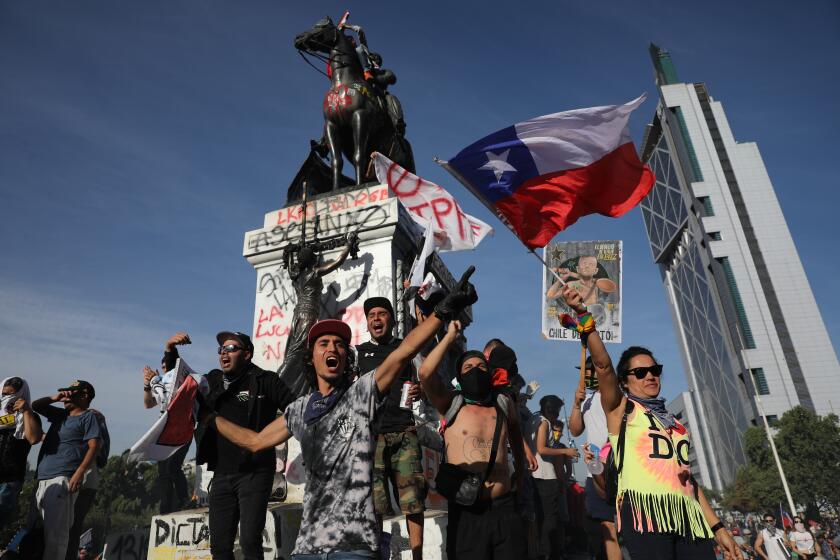Ghosts in the water: Carolina Caycedo’s river portraits and video apparitions tell difficult stories
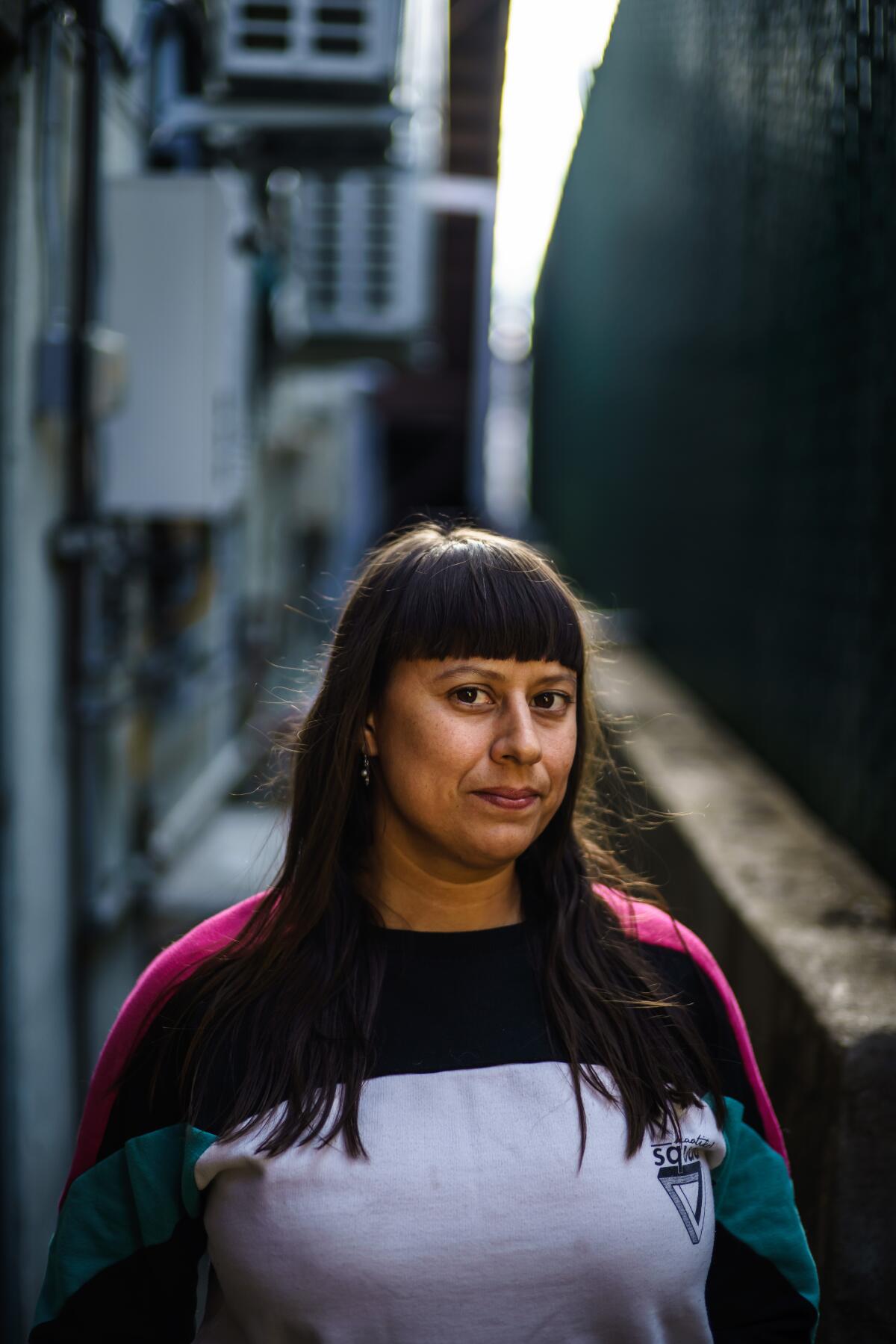
Climb the steps to the second-floor galleries at the Orange County Museum of Art’s temporary exhibition space in Santa Ana and you will find yourself under water. Overhead, a river streams. On the floor meander two more. Water cascades from ceilings and pours out of walls. Water flows from one room into the next.
OCMA is not flooded. It is harboring a series of installations by artist Carolina Caycedo that feature kaleidoscopic renderings of rivers printed onto billowing fabrics that undulate from gallery to gallery.
In one space sits a massive pair of serpentine pillows bearing watery patterns, sculptures that serve as seating for a video that shows waterfalls flowing backward and rivers that spill into themselves.
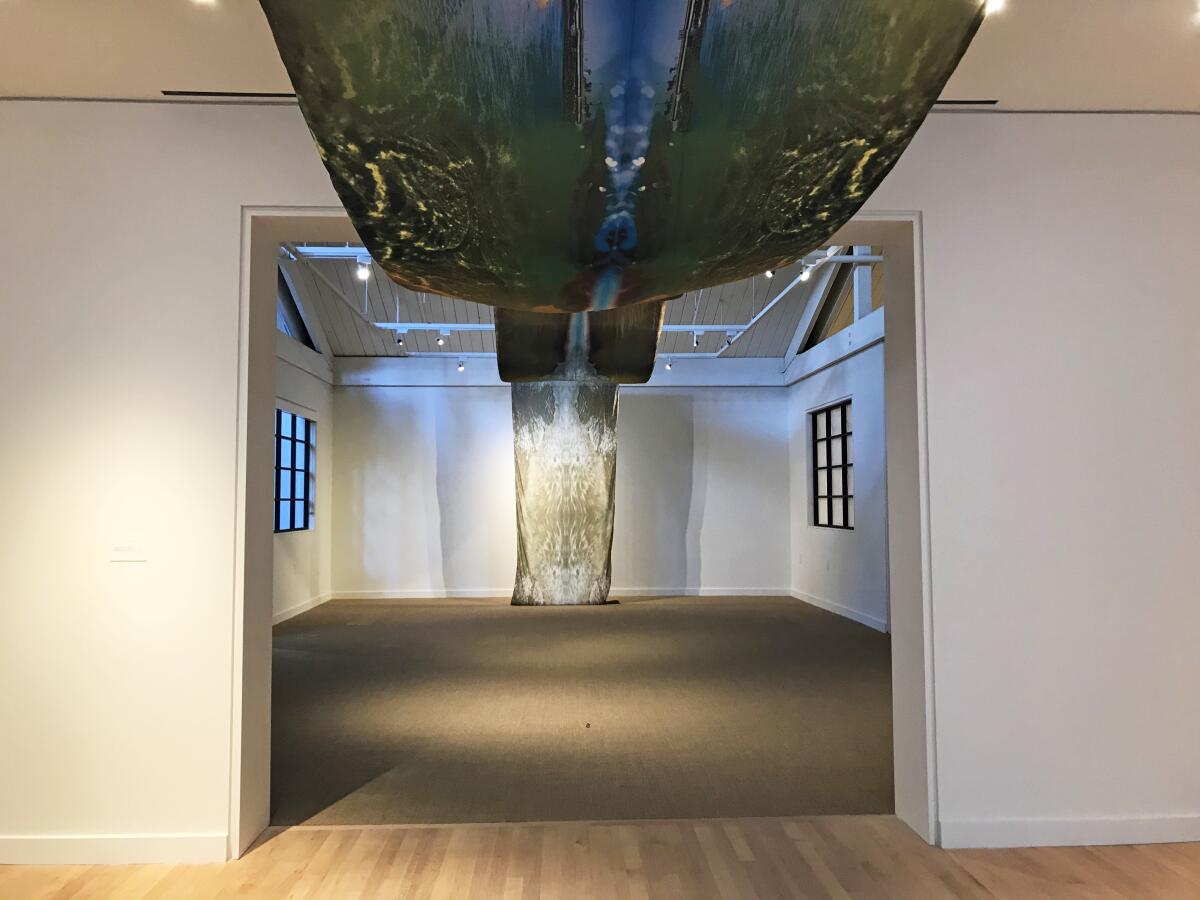
These are no ordinary landscapes. In fact, the Los Angeles-based artist deliberately avoids using the word. She prefers to describe them as “water portraits.”
“The term ‘landscape’ has been used as a window to separate the human viewer from that ecosystem,” explains Caycedo, 41, seated over a cup of hot tea in her chilly Chinatown studio late last month. “What I want to do with the water portrait is note that we are not outside of that.”
Her ongoing exhibition at OCMA, “Wanaawna, Rio Hondo and Other Spirits,” contains images of bodies of water in Europe, North and South America. It also features a pair of new commissions by the museum: water portraits of the San Gabriel and the Santa Ana Rivers, which Caycedo tracks from their headwaters through dams and industrial canals and eventually out to sea. Wanaawna is a nod to the Santa Ana River’s original Tongva name, and Rio Hondo, Spanish for “deep river,” is the name of the tributary that meets, runs parallel to and intertwines with the San Gabriel River.
“Wanaawna Meets Salty Waters,” the portrait of the Santa Ana (the largest river in Southern California), dips down over the museum’s staircase, with patterns in green as well as more toxic shades.
“That shows a moment in which the river is running freely, to this point where you see these crazy chemical colors,” she says, “then after it is dammed. It has this narrative.”
For roughly half a dozen years, Caycedo has made work that touches on water — its environment, its politics and the ways in which we regard it.
In 2015, she staged a performance titled “One Body of Water” for the arts organization Clockshop that told the stories of three contested rivers in the Americas. Two years later, her elaborate “Serpent River Book,” a 72-page accordion book inspired by riverine themes, was featured in the group exhibition “A Universal History of Infamy” at the Los Angeles County Museum of Art.
In recent years, her work has seen rising institutional attention across the United States.
In addition to her ongoing solo show at OCMA, on view through March 22, Caycedo recently displayed a mural-sized collage that dealt with the destructive nature of dams at the most recent iteration of the Chicago Architecture Biennial.
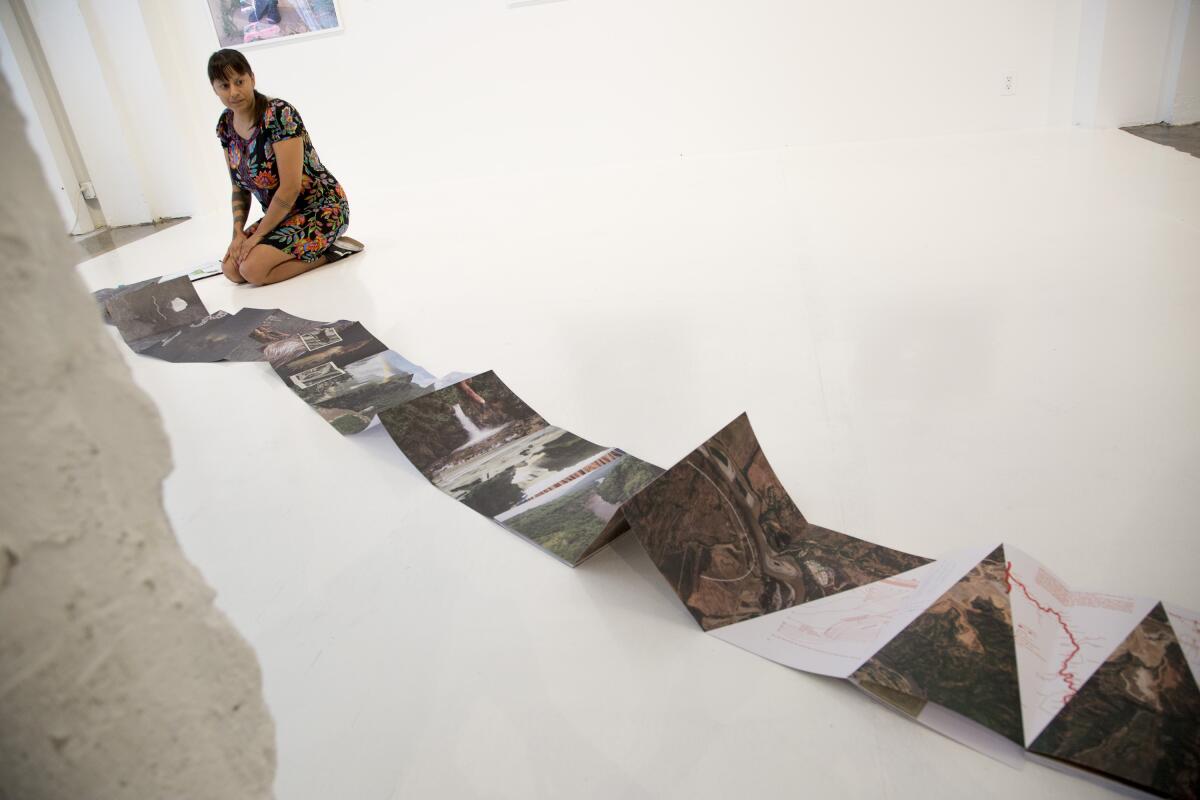
Later this month, she will display a series of fishing net sculptures in a solo show at the Institute of Contemporary Art Boston. In the fall, she will be the subject of a 10-year survey at the Museum of Contemporary Art in Chicago focused on her “Be Dammed” series, the body of work that contains many of her water-themed pieces.
Ghosts in the galleries
While the politics of water have been a central theme, Caycedo’s explorations extend well beyond that.
Her work delves into issues of environmental justice, feminism and displacement. She is also a keen observer of the ways in which historical narratives are deployed: what they put forth and what, for purposes of myth-making, they leave out.
This year’s Chicago Architecture Biennial explores the real-life consequences of urban inequity — such as the explosive protests in Chile and Hong Kong.
In 2018, as part of a partnership between the Vincent Price Art Museum and the Huntington Library, Art Museum, and Botanical Gardens, she was invited to make a work inspired by the Huntington’s collection and grounds. The result was a stirring 10-minute video titled “Apariciones/Apparitions” that was a collaboration with choreographer Marina Magalhães and filmmaker David de Rozas (and is on view until next month).
The piece features dancers — black, brown and queer — inhabiting the Huntington’s library, its galleries and the gardens. Figures appear and disappear. Their bodies slide down a staircase. They shudder and sway. They stare down the camera. They haunt.
The performance is hypnotic — adding flashes of the African and the American to the Huntington’s European-style setting. (Many of the performers wear yellow, a color associated with Oshun, a Yoruban river deity of West African origin that also materializes in Caribbean and Brazilian culture.) It also puts human form to the nameless individuals who make wealth on the scale of Henry Hungtinton possible.
Gauzy narratives of the past can bring status and glory to a place, notes Caycedo. “So what happens if the past rebels and comes back and says, ‘You’re not going to use me in the way you want and I’m going to inhabit it in the way that I want.’”
The Huntington’s chief curator of European art, Catherine Hess, says that Caycedo’s work “subverts” the institution while infusing it with “new voices.” All without feeling didactic. “It’s much more poetic than that,” she says. “It inhabits this spiritual past.”
The Huntington acquired “Apariciones” as a shared work with the Vincent Price. It is the first video ever to enter the Huntington’s permanent collection.
If Caycedo’s approach to art seems global, it is because she is global herself.
Born in London to Colombian parents, she spent her earliest years in England, but moved back to Bogotá in the mid-1980s, when she was still a child. As she approached adolescence, her father relocated the family to Girardot, a town on the banks of the Magdalena River, where he worked in agriculture, growing basil.
“I was a teenager and I hated it,” says Caycedo with a rueful smile. “It was so small. I was a weirdo. I was into reading and theater.”
But it gave her early exposure to the seasonal cycles of life on a river: the rise and fall of the water, the seasonal plantings, the family trips to more remote tributaries. “My father had a friend with a boat and they would take us upstream where it was clear,” she recalls.
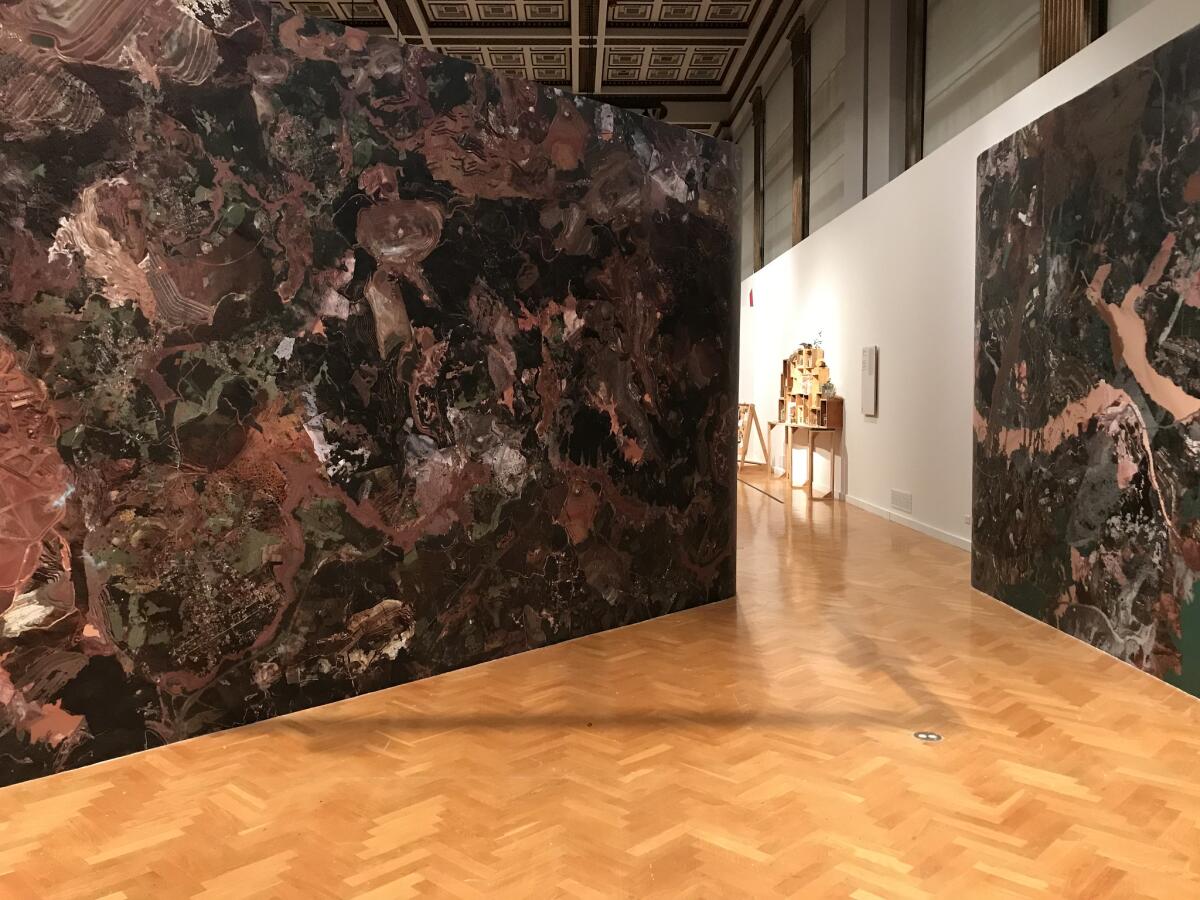
Voice for performance
When it came time to go to college, she enrolled at the Universidad de Los Andes in Bogotá with plans to study art (the closest thing she could find to theater in a degree program) and law (to please her parents).
By the end of the first semester, she had dropped law.
“The moment I discovered performance art I was like, oh, this is better than theater,” she says. “The fact that you didn’t have to get into another character and you could use your own voice.”
It was also cheap to stage and, in many ways, familiar.
“Bogotá, as in any other capital in the Americas, the street is bustling,” says Caycedo. “People are selling you sweets and singing in the bus. So, using the body in public space, I felt entitled to the public space.”
Caycedo collaborated with a friend on a performance that commemorated the sites of rapes. She also teamed up with fellow artists to establish Colectivo Cambalache, a group that undertook numerous public actions — among them, a piece titled “Museo de la Calle” (Museum of the Street), in which they bartered for goods with residents from El Cartucho, a downtown slum that has since been razed.
“It was a way of acquiring these cultural objects before it was erased,” she says. The project was later exhibited in the Palais de Tokyo in Paris and the Istanbul Biennial.
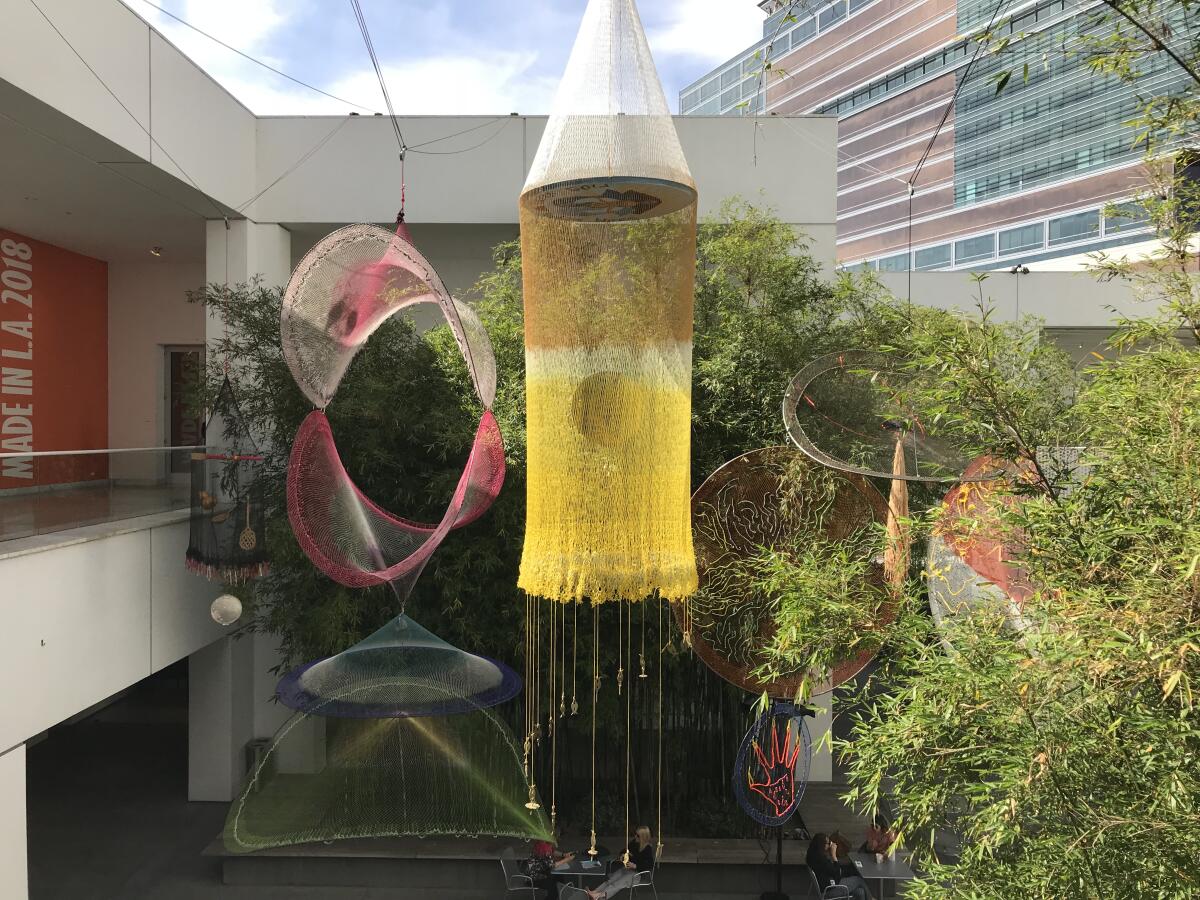
Following graduation in 1999, the artist moved to London for several years, during which she worked as a guard at the Tate Gallery. (“It was boring. Imagine William Blake for six months every day.”) This was followed by seven years in Puerto Rico, where, among other things, she taught at the Escuela de Artes Plásticas in San Juan and worked with the arts nonprofit Beta-Local. (She is currently wrapping up a term on the board.)
Throughout, she has moved with ease between solitary work and collective activity, between official art world sanctums and improvised actions on the street.
Caycedo first landed in Los Angeles in 2009 at the invitation of curator Adrian Rivas, who was then managing a downtown art space called g727. Rivas and his wife, curator Pilar Tompkins Rivas (now director of VPAM), picked her up at the airport, then whisked her off to meet artist Sandra de la Loza, who took them on a tour of Chicano murals.
“I really fell in love with the city,” says Caycedo. At g727, she staged an action called “DAYTODAY,” in which she established a barter system for goods and services. “I met so many people through that.”
Two years later, she was back in L.A. to complete a master’s in fine arts at USC. The city has been her home ever since.
Dam ideas
As an artist who has always been interested in the politics of the public sphere, it was probably just a matter of time before the issue of water became a subject.
While conducting research during a residency in Berlin in 2012 Caycedo found a map of the city’s water and sewage systems, which revealed that even as the city had been split in two by the Berlin Wall, its sewage system remained one.
“When they divided the city, they had only one water treatment plant,” she told me during a 2017 interview. “So it’s this amazing thing: The capitalist s— was sent to the communist part and the water was cleaned and then sent back.”
The map partly inspired her “Serpent River Book,” which features maps as well as photography, poetry and other imagery, and which unfolds in the shape of the boundary once occupied by the Berlin Wall.
During that same period, Caycedo was following the myriad controversies surrounding the construction of the nearly $1 billion El Quimbo Dam on the Magdalena River in Colombia — the river where she had grown up. The dam would halt the river’s natural cycles and destroy communities in the process, often ones that were poor, black and indigenous.
For Caycedo it became as much an activist cause as an artistic one.
“It was a great opportunity to go back,” she says. “It was something I was longing for, this window to connect again.”
With fake Aztec carvings and real Tijuana wedding photos, Rubén Ortiz Torres and Yvonne Venegas capture hybrid states in separate shows at MUAC in Mexico City
If her work offers lessons in water politics, it also offers alternatives to Western ideas about nature.
At OCMA, a nine-minute video — another collaboration with Magalhães and De Rozas (who is also Caycedo’s husband) — features dancers draped in her textile water portraits moving through the waters of the Santa Ana and San Gabriel Rivers, uniting human body and water body into one.
The piece opens with a quote from the writings of indigenous scholar Charles Sepulveda, who taught at Cal Poly Pomona and is now assistant professor of ethnic studies at the University of Utah. In 2018 he published an essay that looked at how views of the Santa Ana River had evolved through the process of European colonization, how natural cycles of dryness and flooding have come to be seen with suspicion, how formerly sacred natural sites have become entombed in concrete.
The essay, titled “Our Sacred Waters: Theorizing Kuuyam as a Decolonial Possibility,” calls for a re-framing of the ways we see landscape: not as something to be dominated, but as a place in which we are but temporary guests. (Kuuyam is the Tongva word for guest.)
“It is a defiant act of love for our lands,” writes Sepulveda, “placing them above the needs of humans.”
“She’s interested in turning the gaze, in making this a portrait of something dynamic and living,” says OCMA senior curator Cassandra Coblentz. “She has a great humility for that perspective on the land.”
“It’s trying to unlearn the way we see rivers,” says Caycedo.
Our polluted, chopped up, canalized, dammed and damned rivers.
“These are bodies,” she adds, “with political agency.”
Carolina Caycedo: Wanaawna, Rio Hondo and Other Spirits
Carolina Caycedo: Wanaawna, Rio Hondo and Other Spirits
More to Read
The biggest entertainment stories
Get our big stories about Hollywood, film, television, music, arts, culture and more right in your inbox as soon as they publish.
You may occasionally receive promotional content from the Los Angeles Times.
